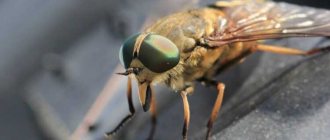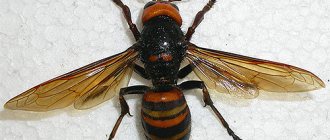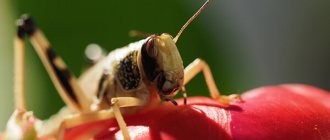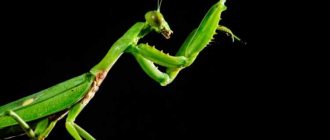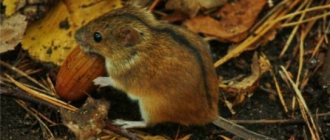Review author: “ZooVita”
The dragonfly is an arthropod insect. As scientists have found out, they appeared on Earth about 350 million years ago. Since then, many different species have emerged, and scientists now know of approximately 6,600 species of dragonflies. Of these, 608 are fossils, so unfortunately they can no longer be found. They are superb predators and some of the most beautiful insects to exist on the planet.
Dragonfly insect lifestyle
Basically, dragonflies live and get food alone. But sometimes they gather in groups of several individuals.
Almost all varieties of these insects are active during the day, because that is when they hunt. Also during the day they fly long distances moving across various territories. Towards noon, in hot weather, dragonflies accumulate near rivers and reservoirs.
Structure of a dragonfly
The dragonfly is very recognizable. Its special feature, by which almost any person recognizes it, is its very narrow, elongated abdomen and graceful wings.
The abdominal part is divided into 11 segments. Each of which in turn is divided into two half-segments. The ternite is the upper half-ring, and the sternite is the lower half-segment. Often the abdomen has a bright, variegated coloring.
Males have special forceps on their abdomen that help them hold the female during the fertilization process.
One of the features of the dragonfly is its eye apparatus. It may seem that there are only 2 of them, but this is not so. Each eye apparatus is approximately 30,000 facets. Each facet is completely independent and works separately. The upper part of the eye sees the outlines of surrounding objects, the lower part distinguishes colors.
But that's not all. Dragonflies also have 3 more eyes. They are located on the parietal part of the head and thanks to them the predator can see behind and to the side. Because of this eye structure, dragonflies can see prey at a distance of 8 meters. But at the same time, dragonflies are absolutely deaf and blind.
Also, when describing dragonflies, we must not forget about the wings.
Previously, the wingspan of a dragonfly was about 90 cm. Now, of course, they are no longer so huge. Nowadays, the maximum size of these insects very rarely exceeds 10 cm in wingspan. But such a small size does not prevent them from hunting and getting food for themselves; on the contrary, the dragonfly is rightfully considered one of the best predators among insects.
Beauties
In general, the order of dragonflies stands out among other orders of insects for its aesthetic merits. And it’s basically impossible not to admire the representatives of the family of beauties. For example, beautiful girls are small (up to 5 cm long), thin even-winged dragonflies with a wingspan of no more than 7 cm. The body and wings of males are colored in blue, green, purple shades and have a metallic sheen.
In females, the body is colored, but the wings are not. Beauties prefer the overgrown banks of quiet rivers and small streams. They lay eggs in the leaves of coastal plants; The larvae also try to stay close to the stems and roots. The flight of a beautiful girl resembles the flight of a butterfly.
Types of insect dragonfly
Dragonflies are divided into three suborders. Homoptera and heteroptera. The third suborder has common features of the first two, but is not widespread. Basically, these types of dragonflies can only be found in India and Japan.
Homoptera dragonflies fold their wings when landing. Both pairs of wings are long and narrow. Despite the fact that each pair's work is autonomous, they are surprisingly harmonious.
Different-winged dragonflies never fold their wings. They are always straightened. In appearance they are very different from Homoptera.
Their wings are of different lengths and shapes, and the back pair of wings is thicker at the base.
It's hard to see in flight, but if you look at a photo of a dragonfly, this one will be very noticeable.
Such wings allow the dragonfly to catch almost any prey. As scientists have found, the percentage that a predator will catch its prey is 95%. This is an incredible amount.
Their powerful jaws help dragonflies absorb prey. They are so strong that they can turn a caught insect into flour in seconds.
Born predator
Without exception, all types of dragonflies (both nymphs and adults) feed on insects, often blood-sucking (horseflies, mosquitoes, midges). The dragonfly's body shape is ideal for hunting on the fly. These insects are “lean”, with a pronounced chest and elongated abdomen. The head of a dragonfly is very mobile. There are two complex compound eyes on it, allowing the insect to see everything that happens around and behind, and between these two there are ordinary ones, which serve for orientation in space. The organs of vision are designed in such a way that a dragonfly sees best against the sky. Therefore, she attacks the victim from below. The insect has a powerful mouth (“gnawing,” as scientists say), short antennae and stiff legs covered with hairs that help capture prey. Each representative of the order has two pairs of wings, which are equally well developed. This means that it is a bimotor insect. Dragonflies can fly at speeds of over 55 km/h.
Dragonfly nutrition
What do dragonflies eat? These are predatory insects. They feed on small insects such as flies, moths and others. Some species can eat small aquatic animals, fish, and spiders.
Each male has a specific hunting territory, which he jealously guards.
Like adult dragonflies, naiads, and predators. Dragonfly larvae feed on fish fry, small aquatic insects, crustaceans and eggs of other insects.
Arrows
Arrows are not as spectacular as beauties, but just as graceful dragonflies. The photo of the graceful arrow, posted below, confirms this fact.
Shooters lead the same lifestyle as beauties, except that they choose more modest prey. And it is not surprising, because the body length of the graceful arrow is only 3.5 cm, while the wingspan is 4.5 cm. The male has an elongated blue chest with a longitudinal black stripe and a black abdomen, as if intercepted by thin blue rings. The wings are narrow and transparent. Some females have a similar coloration, others are rather inexpressively colored and have neither stripes nor rings. Arrows fly slowly and rarely leave their homes. Their larvae live and hunt in the stems and roots of aquatic plants. Distinguishing one species from another within this family is not an easy task. But it is impossible to confuse them with another family of arrows.
Dragonfly insect reproduction
Males fertilize the dragonflies they like right in flight. The only thing romantic about their relationship is the mating dance they perform before copulation.
Despite the absence of any relationship between individuals, until the moment of fertilization, males are very jealous. This is manifested in the fact that during copulation, the male scrapes out the gene pool of the female’s previous partner and lays down his own. Some males keep an eye on the female for some time after, driving away too annoying suitors.
Dragonflies lay their eggs in water or on plants growing in water. Some dragonflies even dive underwater, choosing the best place for their offspring.
Female dragonfly
After about a month, from 14 to 35 days, the larvae of dragonflies and naiads hatch from the eggs.
Like adults, naiads are predators. They hunt prey by releasing a powerful stream of water and thereby knocking the victim down.
Naiads breathe using special gills located in the hindgut. To obtain oxygen, they suck in water through the anus, and then release the processed liquid in a powerful stream. With the help of this jet they move, using it as a kind of engine.
The dragonfly lives in the form of a naiad from 1 to 3 years. It then crawls onto a plant stem protruding from the water and moults, shedding its naiad appearance and becoming a full-fledged dragonfly.
Ophiogomphus cecilia
The horned grandfather can reach 5.8 cm. An olive-colored dragonfly with black rings on its abdomen. The name was given because of the growths on the head that resemble horns.
They are also called horned snake eaters. They live in Eurasia. They prefer the banks of quiet rivers and streams. They have individual hunting grounds.
How long does a dragonfly live?
The dragonfly may seem to live a long time. But this is far from true. How long does a dragonfly actually live? Of course, each species of these insects has its own characteristics and its own lifespan. But as we managed to find out, dragonflies live from 1 to 1.5 months.
Leucorrhinia dubia
The dubious whitebill lives in peat bogs from northern Europe to Siberia. In Russia you can find it almost everywhere, with the exception of the Far East.
The dragonfly has a white muzzle, the top of its abdomen is covered with juicy spots of tangerine color. Grows no more than 3.6 cm.
The benefits and harms of dragonflies for humans
Dragonflies bring both harm and benefit. They eat harmful insects, for example, they eat the Tsetse fly, which is deadly to humans. In addition, they themselves are food for birds and some amphibians.
But the immoderate appetite of naiads and adult dragonflies leads to the fact that some insects disappear from the face of the earth altogether. And also the eating of fish fry by naiads leads to the disappearance of some species of fish.
